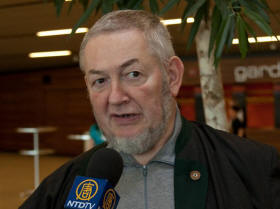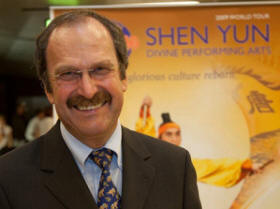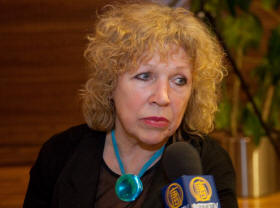(Clearwisdom.net) The Shen Yun Performing Arts attracted a distinguished and diverse crowd on the evening of April 5, 2009, at the Wiener Stadthalle, in Vienna, Austria. Among them was Dr. Kuehrer, an economist and diplomat who also works as a democratization expert for the Organization for Security and Co-operation in Europe, United Nations Organization, and several other organizations. He has been to China several times, and has studied Chinese.

Dr. Kuehrer, an economist and diplomat who also works as a democratization expert for the Organization for Security and Co-operation in Europe, United Nations Organization.
"I like it quite a lot," Dr. Kuehrer said of Shen Yun. "It was a performance that entailed music, dance and also a little philosophy. I actually expected more circus and artistic things. But, this was for certain a wrong idea, as the underlying philosophy goes in the direction of tolerance, compassion, peacefulness and unity."
Dr. Kuehrer spoke about human rights in China, some of which Shen Yun touches on, and several other topics. "Yes, [it was] a beautiful impression of color--beautiful dances and movement, but also unexpectedly more than I had thought," he said, commenting that Shen Yun had given "harmonic expression" to current events in China. "This I will remember, and for that, I thank you."
Mr. Ufertinger, the principal of a German school, and his wife, traveled to Vienna especially to see the performance. He has traveled quite often to the "Middle Country" and is especially fascinated by the Chinese rural area people. Mr. Ufertinger has been in Lahsa, Tibet's capital, and is familiar with the snow-covered Himalayas, depicted in the piece "Dance of the Snow-Capped Mountain."

Mr. Ufertinger, the principal of a German school, and his wife, traveled to Vienna especially to see the performance
"The dances are outstanding. We have quite a good understanding of Chinese culture. When one sees something like this, one suddenly feels great again. Also the music was very soulful and in connection with the dances," praised Mr. Ufertinger.
"If one sees the scene, "Dance of the Snow-Capped Mountain" and then thinks about Tibet, one has great feelings. This truly reminds of Tibet."
Mr. Ufertinger also commented, "I am totally impressed with the backdrop pictures. It is fantastic and the combination of backdrop pictures is just marvelous. Also the dances and the backdrop picture merge into one. After seeing the first scene, ["The Five Millennia Begins"] when the gods and Buddha's come down to earth and then return, this was done beautifully."
A friend had recommended that Mr. and Mrs. Ufertinger see the show. "So, we said that we definitely had to see this show. The trip to Vienna was worth its while."
During the evening performance, audience member Ms. Kiener, an author and producer, came to see the show twice. She said, "I'm excited. I was already here this afternoon. I have looked at this for the second time. I don't regret it at all. I'm very happy that I can see it again, because I noticed many new things."
Ms. Kiener, author and producer, came to see the show twice
Ms. Kiener is German and is from Munich. She traveled about 500 kilometers to see the show after a friend suggested she attend. "Now, I'm truly pleased that I'm here." When asked what her favorite part of the show was, Ms. Kiener replied, "I don't dare to say that. But, what I found exceptionally beautiful is the Tibetan dance and next the solo with the wonderful two-stringed violin [Erhu]. It was unbelievably beautiful."
"I also was impressed with the scene about the persecuted husband. This was truly very, very touching. But, it is most difficult to make a decision because there was so much beauty. Beautiful was also the welcome of the spring and the beautiful flowers. There are totally different aspects and a great mixture."
Ms. Kiener writes screenplays and radio dramas, which she directs and lyrics herself. "As I'm a producer, I find it great to be able to see dancers that one can read the [expression] on the faces and that one can study the faces. What I admired enormously was the ardor on the faces even though they had to be highly performing. Actually, one would think that they would be very stressed, but everything looked so easy and graceful. This is marvelous and it was the same with the men and women. Unbelievably beautiful!"
Mr. Makra, an artist, painter, and photographer has been very interested in Chinese painting as well as Chinese culture. He said, "It was as if the heavens opened. It is as if one remembers faintly that one has seen the heavens. This was my impression." He added that Shen Yun, "...spoke to all the senses. I believe that beauty is the highest truth. I think that this show is a hymn to beauty. Well, we Europeans might find this a bit corny. For us, beauty without any problems is usually uninteresting. But, I believe that Asian culture is different. They view beauty differently. Beauty is an expression of energy, inspiration, and spirituality. This is what touched me the most."

Mr. Makra, an artist, painter, and photographer
"It brought me closer to Chinese spirituality, perhaps also the world. I felt that. This special interpretation of Chinese mythology was very well presented. The sensual and graceful beauty could also be a message to the world, just as Goethe said, 'Art is the sister of religion.' This was very well done here. When this awakens in China it will result in a peaceful turn. If one changes from the innermost thoughts and by identifying with it, reconnecting with ones roots and so on, then a peaceful turn will happen. This is what touched me very much and what gave me great happiness. I'm very grateful that I saw this today."
Mr. Makra added that this cultural foundation is "...very important, especially in today's times. This is what I felt to be the strongest message--just this form, this really intensive form of grace."
He said that in Asian cultures in the past, there was more harmony between the sexes, which was reflected in their arts and dance. "In Asia, the man polarizes more, and in Europe, men are like women and women are like men. In Asia, it is that the man governs and not the woman. It is like in China that the woman is Yin and the man is Yang. At least it was like this in the past. I don't know what is going on today," he said.
Speaking of the dance "Heaven Awaits Us Despite Persecution," he said, "That was very brave. I find it very brave that the problems are represented by these scenes. I know about it [the persecution]."
As a painter, Mr. Makra particularly enjoyed Shen Yun's backdrops, "Very beautiful! Very beautiful! I found especially the last picture on the backdrop very successful. It was fantastic, just fantastic! Because it was not just symbolic, but something universal. I found the last picture as the most modern of all and the most beautiful among all."
Source: http://theepochtimes.com/n2/content/view/14924/
http://theepochtimes.com/n2/content/view/14927/
http://theepochtimes.com/n2/content/view/14925/
http://theepochtimes.com/n2/content/view/14921/
Category: Shen Yun Performing Arts






